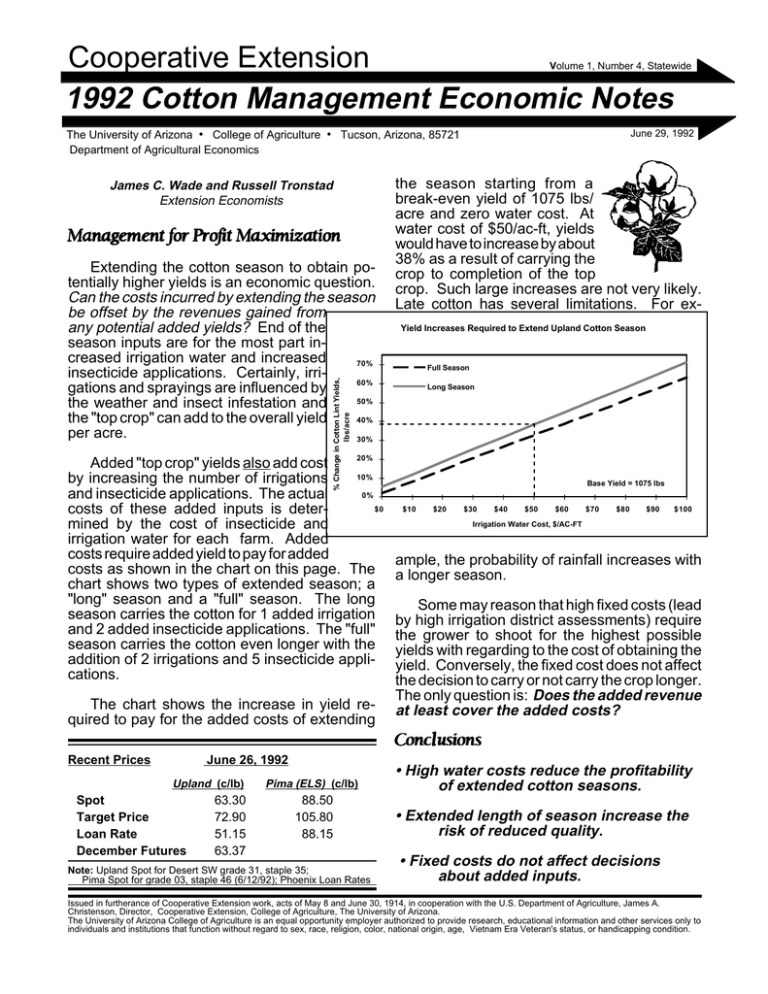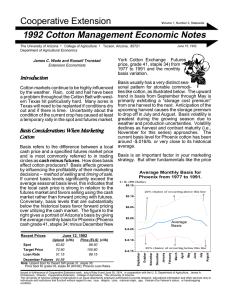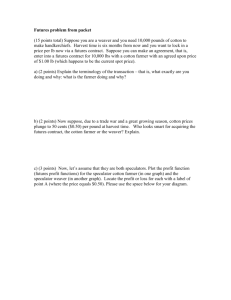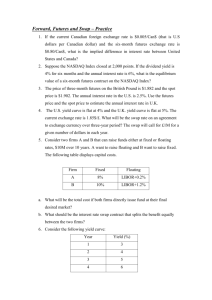1992 Cotton Management Economic Notes Cooperative Extension •
advertisement

Cooperative Extension 1992 Cotton Management Economic Notes Volume 1, Number 4, Statewide June 29, 1992 The University of Arizona • College of Agriculture • Tucson, Arizona, 85721 Department of Agricultural Economics James C. Wade and Russell Tronstad Extension Economists Management for Profit Maximization Yield Increases Required to Extend Upland Cotton Season Full Season % Change in Cotton Lint Yields, lbs/acre Extending the cotton season to obtain potentially higher yields is an economic question. Can the costs incurred by extending the season be offset by the revenues gained from any potential added yields? End of the season inputs are for the most part increased irrigation water and increased 70% insecticide applications. Certainly, irri60% gations and sprayings are influenced by 50% the weather and insect infestation and the "top crop" can add to the overall yield 40% per acre. 30% the season starting from a break-even yield of 1075 lbs/ acre and zero water cost. At water cost of $50/ac-ft, yields would have to increase by about 38% as a result of carrying the crop to completion of the top crop. Such large increases are not very likely. Late cotton has several limitations. For ex- 20% Added "top crop" yields also add cost 10% by increasing the number of irrigations 0% and insecticide applications. The actual $0 costs of these added inputs is determined by the cost of insecticide and irrigation water for each farm. Added costs require added yield to pay for added costs as shown in the chart on this page. The chart shows two types of extended season; a "long" season and a "full" season. The long season carries the cotton for 1 added irrigation and 2 added insecticide applications. The "full" season carries the cotton even longer with the addition of 2 irrigations and 5 insecticide applications. The chart shows the increase in yield required to pay for the added costs of extending Recent Prices June 26, 1992 Upland (c/lb) Spot Target Price Loan Rate December Futures 63.30 72.90 51.15 63.37 Long Season Base Yield = 1075 lbs $10 $20 $30 $40 $50 $60 $70 $80 $90 $100 Irrigation Water Cost, $/AC-FT ample, the probability of rainfall increases with a longer season. Some may reason that high fixed costs (lead by high irrigation district assessments) require the grower to shoot for the highest possible yields with regarding to the cost of obtaining the yield. Conversely, the fixed cost does not affect the decision to carry or not carry the crop longer. The only question is: Does the added revenue at least cover the added costs? Conclusions Pima (ELS) (c/lb) • High water costs reduce the profitability of extended cotton seasons. 88.50 105.80 88.15 • Extended length of season increase the risk of reduced quality. Note: Upland Spot for Desert SW grade 31, staple 35; Pima Spot for grade 03, staple 46 (6/12/92); Phoenix Loan Rates • Fixed costs do not affect decisions about added inputs. Issued in furtherance of Cooperative Extension work, acts of May 8 and June 30, 1914, in cooperation with the U.S. Department of Agriculture, James A. Christenson, Director, Cooperative Extension, College of Agriculture, The University of Arizona. The University of Arizona College of Agriculture is an equal opportunity employer authorized to provide research, educational information and other services only to individuals and institutions that function without regard to sex, race, religion, color, national origin, age, Vietnam Era Veteran's status, or handicapping condition. Estimated To-Date Production Costs $/lint lb (June 29) The following table gives estimated production costs/lb to-date. These costs include both growing and fixed or ownership costs and are based on the displayed target yields. Producers with higher yields will have lower costs/lb if input costs are the same. Growers with lower yields will have higher costs/lb. County Target Yield Yuma 1,300 1,300 1,100 1,250 1,300 1,100 700 1,050 850 La Paz Mohave Maricopa Pinal Pima Cochise Graham Greenlee Growing Costs June To Date .04 .04 .02 .02 .04 .06 .04 .06 .08 .10 .13 .13 .11 .17 .13 .33 .20 .19 Fixed All Costs Cost To Date .25 .27 .23 .23 .26 .28 .42 .31 .36 .35 .40 .36 .34 .43 .41 .76 .51 .55 Note: Based on Wade, et al., “1992-93 Arizona Field Crop Budgets”, Various Counties, Arizona Cooperative Extension, Tucson, January 1992. What Marketing Tools Should a Cotton Producer Utilize? Cotton growers in Arizona have a relatively wide array of marketing tools available compared to other crops like alfalfa, fruit, nuts and vegetables. This gives cotton growers greater flexibility in their marketing plan but also raises more questions as to what strategy is “best” or rather most suited for a grower’s financial situation, cost of time, marketing expertise, and degree of “risk preference.” Marketing tools available include “cash marketing,” forward contracting, New York Cotton Exchange (NYCE) futures and option contracts and marketing coops. Many marketing cooperatives like Calcot offer growers marketing flexibility by directly or indirectly utilizing NYCE futures and options so that a mix of marketing tools is available and needs to be considered by everyone. Traders at the NYCE gather buy and sell orders and information from individuals all over the world and vocal outcries of sale transactions in the pit determine the NYCE market. This market is considered the “base point” or reference market for all local markets throughout the world. Trading occurs for contract months that are in the future for both the futures and option markets. The NYCE serves as a clearing house for all sale transactions so that it is the buyer of all contracts sold and the seller of all contracts bought. How can a cotton producer utilize futures or options as a hedging tool? Because the local market follows the NYCE market, a producer can hedge by taking a position in the futures market that is opposite of his cash position. For hedging the upcoming crop, one could sell December futures now or take a “short position” in the December futures market. Then after harvest, concurrently buy December futures and sell in the local cash market (both quantities equal to your previous short position) before the December futures contract matures in mid-December. If the differential between the cash market and futures (i.e., basis) is the same when December futures were sold as when they are bought back after harvest, a “perfect hedge” is said to have occurred. This means that a producer would receive a net price equal to the cash price when December futures were sold less brokerage fees (approximately $.002 /lb.). Thus, a $.10/lb. price decline in the cash market would be offset with a $.10/lb. gain in the futures market (i.e., buy back December futures for $.10/lb. less than initially sold them for) with a constant basis. Conversely, any price increase in the cash market would be removed by a loss in the futures market with a constant basis. An increasing basis (cash minus futures) would be desirable for the producer hedging with futures but a decreasing basis will decrease the cotton hedgers net price. The NYCE future options market allows producers to place a price floor under their net price received similar to futures as described above but it also allows producers to benefit from an increasing price level. In order to obtain this right, a premium must be paid. Options will be elaborated on in the next issue. Disclaimer: Neither the issuing individuals, originating unit, Arizona Cooperative Extension, nor the Arizona Board of Regents warrant or guarantee the use or results of this publication issued by the Arizona Cooperative Extension and its cooperating Departments and Offices.



